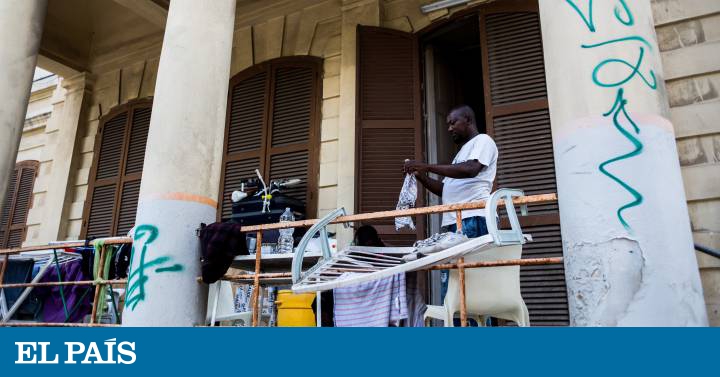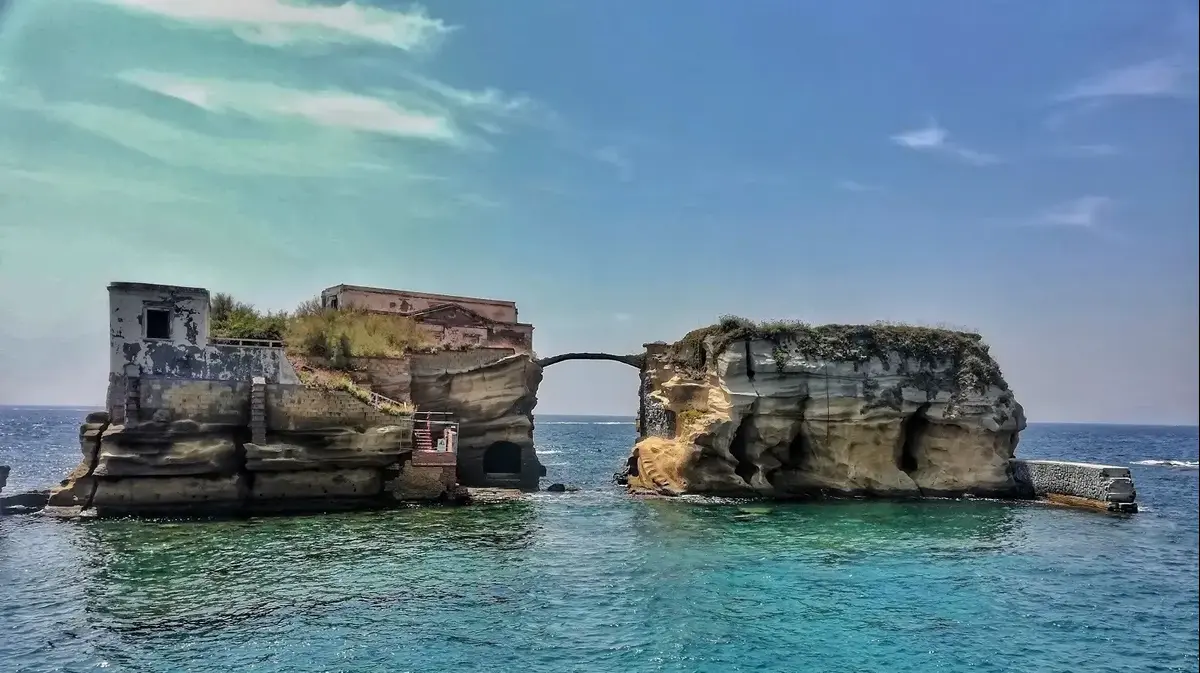The 19th century was drawing to a close when Villa Roth was built in San Pasquale, one of the most popular districts of the Italian city of Bari.
Centuries later, the ancient residence of noble origin, home to a rich family of industrialists who came to southern Italy from northern Europe, is inhabited by 40 people in dire need of a roof.
In the spacious courtyard in front of the gate that gives access to the mansion, a group of children brave the sweltering heat of a summer afternoon to kick a ball a few times.
"Put down your phone and come play!" Shouts the sonorous voice of one of them.
After a few minutes, several players score the first goal on the makeshift soccer field.
MORE INFORMATION
PHOTO GALLERY From abandoned mansion to refuge
Barikama, the agricultural cooperative of exploited migrants that helps its neighbors in Italy
The voices that do tell their stories
Despite having been declared a cultural space since 1990, this building of great historical and artistic value has been in a state of abandonment for 15 years.
After a brief occupation in 2015 by students, migrants, precarious workers and artists - which ended in eviction - the Bari City Council allowed the now empty rooms to become an interesting experiment in self-management and mutual support thanks to the reappropriation of the building by immigrants who have moved to this space after ending up stranded in a camp in the center of the city.
Each inhabitant of Villa Roth has managed to get a corner to live in, and the community management of the spaces is organized in an assembly.
The use of the residence is not for the purpose of obtaining your property.
The idea is that through initiatives and associations dozens of people who do not live in it, but who identify with their community, get involved.
"Since I live here, I no longer run the risk of sleeping on the street again. Without a job, nobody rents you a house," says Moro, originally from Ghana, who fled Libya in 2011 and crossed the Mediterranean by boat.
"With the war, living there became dangerous. In Libya I was no longer safe."
It was the time of the Arab Spring.
Thousands of migrants from North Africa and the sub-Saharan regions set sail for Europe in search of a better future.
However, those who managed to reach its shores did not find the promised land.
A repeated history.
Hundreds of people fleeing the war were loaded onto buses and ferries and transported from one place to another in an unknown country: Italy.
"After Lampedusa they took me to the CARA - acronym for Reception Center for Asylum Seekers, for its acronym in Italian
-
in Bari. As I am not Libyan, Europe does not grant me protection," continues Moro.
At least 750 asylum seekers live in the CARA and receive an allowance of 2.5 euros a day to spend exclusively in the same facilities.
"We asked for a document to be able to move, but no one answered us. For this reason, in May 2011 we occupied the tracks of Bari Palese, a nearby station," adds the young man.
The demonstration was the trigger for the protests that broke out in the following months.
"It was a period of great turmoil. The first of August is an important date. The CARA emigrants blocked the circulation of the trains and the traffic of the city. At the same time, in Nardò the workers were striking for the first time against the intermediaries who illegally recruit labor, "says Gianni, from the Villa Roth community.
The revolt in the detention centers ended with 44 arrests.
A solidarity campaign organized by migrants, associations and groups responded to the repression and the protesters were sentenced to a sentence of house arrest that they had to serve in the center of Bari or in Borgo Mezzanone, in the province of Foggia, near the camps. in which the foremen recruit the emigrants to exploit them in the tomato plantations.
"In 2013 we got a document valid for one year, which we had to renew at the central police station in Bari," recalls Moro.
Many decided to stay in southern Italy and ended up living in the ghettos that arose around the fields of orange, olive and mandarin trees.
They then returned to Apulia, where the future is permanently shrouded in a black cloud of precariousness.
Through initiatives and associations, dozens of people who do not live in Villa Roth, but who identify with their community, are being involved.
Tired of being treated like packages, the asylum seekers broke the thick silence that covered them by occupying the old convent of Santa Clara, near the port of Bari.
In that place, already known as the House of Refuge for having welcomed Greeks fleeing the regime of the generals in the 1950s, some 250 people found asylum.
"We recovered the electricity supply with a generator that ran at night until we went to sleep," says Moro.
"Although there was only one bathroom and the hygienic conditions were bad, for us it was a meeting place. Our friends who slept in the street found there something more than a place to sleep. Everything was provisional. That is why they kept asking for accommodation and routes. of social inclusion ".
When a fire broke out in the old convent, the Bari City Council decided to vacate the building.
"The evacuation was agreed, but the alternative was a tent camp," Moro points out.
The authorities decided that the old SET building - an acronym in Italian for the telephone services company -, a disused warehouse in the Libertà district, could be used to install 19 stores donated by Italian Civil Protection.
Each of them had eight beds, but the number of people to be housed was 150. More than half of the displaced decided to leave because the situation reminded them of the humanitarian aid facilities run by the UN along the Kenya route. Libya, where they had suffered discrimination and painful situations.
Over the months, dozens of people who had fled from the SPRAR project - Protection System for Asylum Seekers and Refugees, for its acronym in Italian - arrived at the camp after spending several nights without a place to stay.
Tents are not cozy spaces.
In winter they have no heating, and in summer the temperature reaches 50 degrees and you have to sleep outside.
Faced with this inhuman scenario, even the xenophobic right wing, which opted to provoke the local population against emigrants, failed in its attempt to take advantage of the situation.
As had already happened during the docking of the
Vlora
, the ship that, in the 1990s, transported 20,000 refugees fleeing the Balkan war to Italy, the inhabitants of Bari set in motion the machinery of solidarity and denounced the unworthy treatment imposed on emigrants.
The Bari City Council proposed to invest 1.6 million euros in building wooden houses.
"We refuse and present our ideas. Why go back to the containers?" Asks Moro.
"We were divided between Villa Alta, a reception center run by a cooperative, and Villa Roth, where I continue to live today. Our struggle did not end then, and in 2019 we started a lawsuit with the Bari City Council. We wanted a registry to be created and residency be granted to asylum seekers ", a right abolished by the Security Decree approved by the Northern League and the Five Star Movement.
Self-management and community
The camp is the symbol of an ineffective reception system and proof that institutional strategies are ineffective in meeting people's basic needs regardless of their place of birth.
In fact, in the old SET building, in addition to the emigrants live Italian families in a situation of "housing emergency."
In this space, in which an enormous paradox has been created, the struggle for the right to live and a dignified life intersect, become collective and transversal, cross borders and tear down the barriers built on the basis of the difference between " we and them".
The wall of marginalization and fragility raised against those who go through moments of particular vulnerability begins to crumble little by little.
"In 2012 I was evicted from a house. Later I lived with my sister, and finally, in the camp. So, the Bari Welfare Department gave me a place in Villa Roth with my husband, who is unemployed, and my daughter".
Mimma is 57 years old and lives in the residence with 40 other people.
The inhabitants of the building, who have a direct relationship with the municipal authorities, meet in an assembly to organize community life.
Mimma has packed an entire house into one room, one of the largest in Villa Roth.
The photos of the unforgettable loved ones hanging on the walls, the coffee pot on the fire and the attention to the details of their surroundings show the desire not to surrender to the silence of the institutions that, after seven years, are still unable to grant you social housing.
"Is the coffee good?" He asks.
"See that table? It's my daughter's bed. I collect the basic state rent, but I can't afford to pay the rent and the bills. What are we supposed to do? We make a living."
Mimma's daughter is 26 years old and works five days a week in a bar for 50 euros a week.
"First he charged 70, then 100, and now half. The coronavirus crisis was what we lacked," says the young woman.
"I have to look for another job. I earn very little."
"Why don't you come to the FuoriMercato / No Borders information point? We are here every week. Maybe we can help you," proposes Gianni, who is part of the helpdesk.
The inhabitants of Bari set in motion the solidarity machinery and denounced the unworthy treatment imposed on emigrants
At Villa Roth, self-management and mutualism combine multiple topics of debate: from the possibility that everyone has a roof to that of "working without bosses."
Villa Roth is not a private property, but a public space connected to the Villa Roth Community association, which is part of the Fuori Mercato national network.
In fact, the group welcomes initiatives that also have the support of people who do not live in the building.
One of them is the SfruttaZero tomato sauce, a project devised in 2014 in the
squatting
of the former Socrates institute during the support of the protests that started at CARA in Bari.
Currently, the project offers work to migrants living in the old mansion and precarious young workers.
At a time when governments design fences and intercept the free movement of people, classifying them as if they were animals, Villa Roth recalls that obstacles can only be overcome by rebuilding bonds of solidarity and in communities based on equality.
You can follow PLANETA FUTURO on Twitter and Facebook and Instagram, and subscribe to our newsletter here.


/cloudfront-eu-central-1.images.arcpublishing.com/prisa/U2R7NZPI4CFAXSB3RA5IFUE2VE.jpg)












